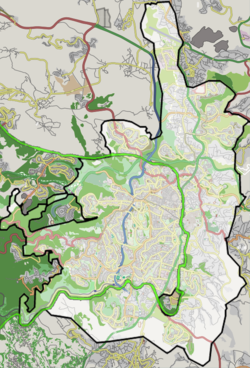
Back وادي هنوم Arabic ܓܗܢܐ ARC وادى هنوم ARZ Hinnom vadisi Azerbaijani Геена Bulgarian Gehenna Catalan جەھەنەم CKB Gehenna Czech Gehenna CSB Gehenna Danish
| Gehenna | |
|---|---|
| Gehinnom Valley of Hinnom | |
 | |
Location in Jerusalem, south of Mount Zion | |
| Naming | |
| Native name | גיא בן הינום (Hebrew) |
| Geography | |
| Population center | Jerusalem |
| Coordinates | 31°46′11″N 35°13′36″E / 31.76972°N 35.22667°E |
| Rivers | Gey Ben Hinnom Stream |
Gehenna (/ɡɪˈhɛnə/ ghi-HEN-ə; Ancient Greek: Γέεννα, romanized: Géenna) or Gehinnom (Hebrew: גֵּיא בֶן־הִנֹּם, romanized: Gēʾ ḇen-Hīnnōm or גֵי־הִנֹּם, Gē-Hīnnōm, 'Valley of Hinnom') is a Biblical toponym that has acquired various theological connotations, including as a place of divine punishment, in Jewish eschatology.
The place is first mentioned in the Hebrew Bible as part of the border between the tribes of Judah and Benjamin (Joshua 15:8). During the late First Temple period, it was the site of the Tophet, where some of the kings of Judah had sacrificed their children by fire (Jeremiah 7:31).[1] Thereafter, it was cursed by the biblical prophet Jeremiah (Jeremiah 19:2–6).[2]
In later rabbinic literature, "Gehinnom" became associated with divine punishment as the destination of the wicked for the atonement of their sins.[3][4] The term is different from the more neutral term Sheol, the abode of the dead. The King James Version of the Bible translates both with the Anglo-Saxon word hell.
- ^ Watson E. Mills; Roger Aubrey Bullard (1990). Mercer Dictionary of the Bible. Mercer University Press. p. 319. ISBN 978-0-86554-373-7.
- ^ Kohler, Kaufmann; Ludwig Blau (1906). "Gehenna". Jewish Encyclopedia. "The place where children were sacrificed to the god Moloch was originally in the 'valley of the son of Hinnom,' to the south of Jerusalem (Joshua 15:8, passim; II Kings 23:10; Jeremiah 2:23; 7:31–32; 19:6, 13–14). For this reason the valley was deemed to be accursed, and 'Gehenna' therefore soon became a figurative equivalent for 'hell.'"
- ^ Kohler, Kaufmann; Ludwig Blau (1906). "Gehenna: Sin and Merit" Jewish Encyclopedia: "It is frequently said that certain sins will lead man into Gehenna. The name 'Gehenna' itself is explained to mean that unchastity will lead to Gehenna ('Er. 19a); so also will adultery, idolatry, pride, mockery, hypocrisy, anger, etc. (Soṭah 4b, 41b; Ta'an. 5a; B. B. 10b, 78b; 'Ab. Zarah 18b; Ned. 22a)."
"Hell". Catholic Encyclopedia: "[I]n the New Testament the term Gehenna is used more frequently in preference to hades, as a name for the place of punishment of the damned.... [The Valley of Hinnom was] held in abomination by the Jews, who, accordingly, used the name of this valley to designate the abode of the damned (Targ. Jon., Gen., iii, 24; Henoch, c. xxvi). And Christ adopted this usage of the term." - ^ Trachtenberg, Joshua (2004) [Originally published 1939]. Jewish Magic and Superstition. Philadelphia: University of Pennsylvania Press. p. 66. ISBN 9780812218626.
© MMXXIII Rich X Search. We shall prevail. All rights reserved. Rich X Search
